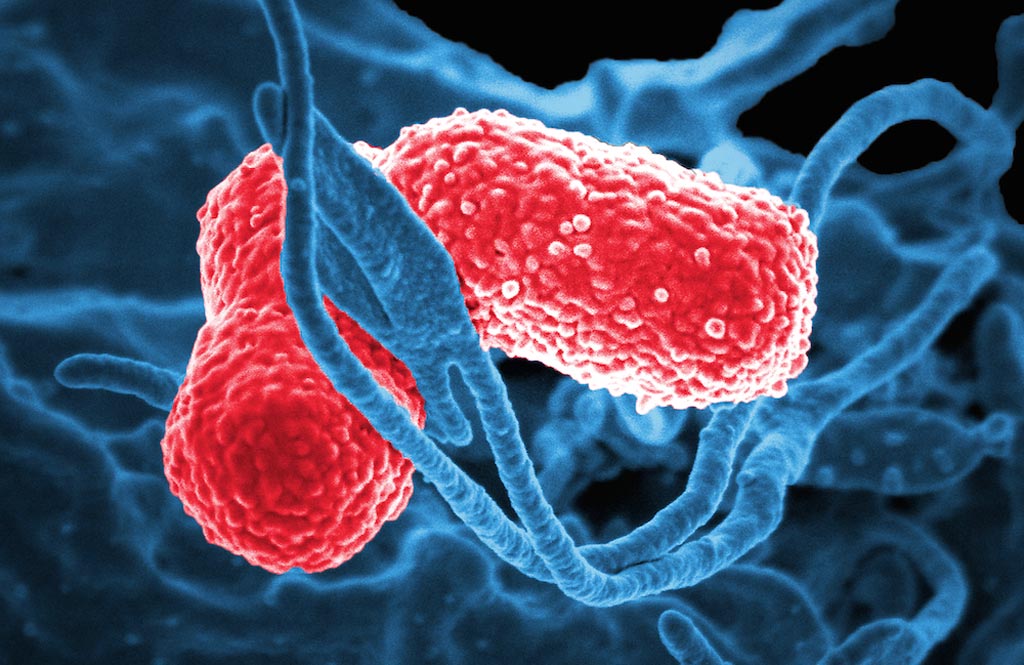Combination of Antibiotics Can Eradicate Super Pathogens
By LabMedica International staff writers
Posted on 08 Jun 2017
ESKAPE pathogens are a group of antimicrobial-resistant bacteria that pose a grave threat, causing more than two million infections and nearly 23,000 deaths a year. The six super bacteria are also responsible for a substantial number of infections in hospitals.Posted on 08 Jun 2017
The emergence of polymyxin resistance threatens to leave clinicians with few options for combatting drug-resistant Acinetobacter baumannii. Combinations of three antibiotics, that are each ineffective against superbugs when used alone, are capable of eradicating two of the six ESKAPE pathogens when delivered together.

Image: A scanning electron micrograph (SEM) of multidrug-resistant Klebsiella pneumoniae gram-negative bacteria that are known to cause severe hospital-acquired infections (Photo courtesy of Dr. David Dorward, PhD).
An international team of scientists collaborating with the University at Buffalo (NY, USA) studied two clonally related, paired, A. baumannii isolates collected from a critically ill patient who developed colistin resistance while receiving colistin methanesulfonate in a clinical population pharmacokinetic study. They evaluated: an A. baumannii isolate collected before (03-149.1, polymyxin-susceptible, MIC 0.5 mg/L) and an isolate collected after (03-149.2, polymyxin-resistant, MIC 32 mg/L, carbapenem-resistant, ampicillin/sulbactam-resistant). The team tested combinations of the antibiotics polymyxin B, meropenem and ampicillin-sulbactam against the pathogen A. baumannii. The bacterium Klebsiella pneumoniae was treated with polymyxin B, meropenem, and rifampin.
The antibiotics were applied to the bacterial samples individually, in pairs and in triple combinations. Both the time needed for the antibiotics to kill the bacteria and the time it took for the pathogens to repopulate was measured. For the tests on A. baumannii, none of the antibiotics were able to kill the bacteria when used alone. Of the pairs of antibiotics, only the grouping of polymyxin B and meropenem was able to effectively kill the pathogen, but the bacteria gradually regrew over three days. The triple combination achieved a similar kill rate to the pair of polymyxin B and meropenem, but the addition of ampicillin-sulbactam prevented regrowth of the pathogen. Within 96 hours, no viable bacteria cells were detected after exposure to all three antibiotics.
In the tests against Klebsiella pneumoniae individual antibiotics were unable to sustain the killing of bacteria over a 24-hour period. The most effective double combination was polymyxin B and rifampin, which killed bacteria for up to 30 hours before the population regrew to initial levels. The triple combination of polymyxin B, meropenem, and rifampin produced the highest kill rates and tripled the time it took for bacteria to regrow to 72 hours. Rifampin, scientists suspect, temporarily suppresses the antibiotic resistance of Klebsiella pneumoniae, allowing the trio to destroy the bacteria.
Justin Lenhard, PharmD, the first author of the investigation, said, “Each antibiotic was chosen to complement the other drugs' mechanisms of bacterial killing. By combining antimicrobials that exert their bacterial killing in different ways, it is possible to outmaneuver the ESKAPE pathogens and completely overwhelm the bacteria's defensive countermeasures.” The most recent study was published in the June 2017 issue of the journal Antimicrobial Agents and Chemotherapy.
Related Links:
University at Buffalo




 assay.jpg)



 (3) (1).png)





